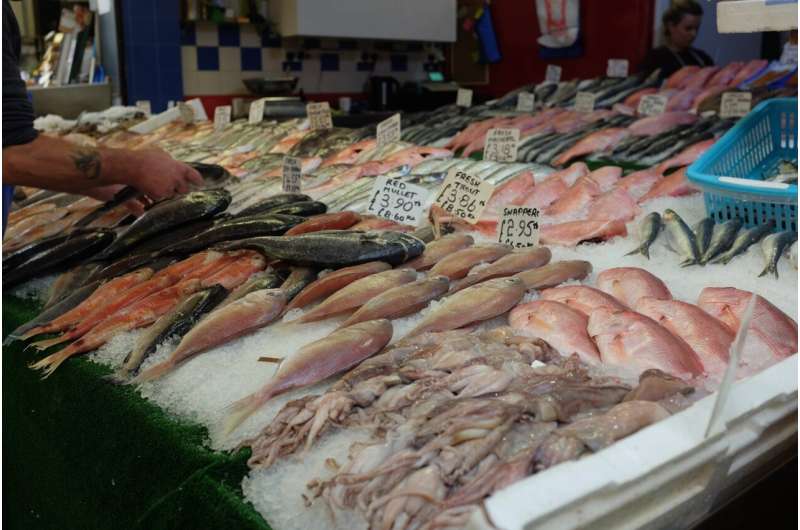What are you really eating? Study finds one in five seafood products are mislabeled

If you eat seafood, you could be without realizing it due to . , and it occurs when the species of fish you think you're buying is not the one you actually receive.
from capture to table , as fish products often pass through . Along the way, products can be or .
For instance, a cheap fish like tilapia may be given the name of a , like red snapper, or an endangered species might be passed off as a .
Seafood mislabeling not only threatens vulnerable marine populations, but makes it harder for people to make informed, ethical choices about the food they eat.
Searching for mislabeling in Calgary
To investigate this issue in Canada, examined mislabeling and ambiguous market names in invertebrate and finfish products—fish with fins, like cod, salmon and tuna—in Calgary between 2014 and 2020. This was the first study of its kind in Canada to compare shellfish to finfish.
University students sampled 347 finfish product and 109 shellfish—including shrimp, octopus and oysters—from Calgary restaurants and grocery stores. These samples were then genetically tested using a species-specific marker called a .
In Canada, the maintains a that provides the acceptable common names for the .
A seafood product was considered mislabeled if it was sold using a name not found on the Fish List for the DNA-identified species. For instance, there is only one species that can be sold under the name salmon: Atlantic salmon. If sockeye salmon was sold as salmon without any other qualifier, it was considered mislabeled.
1 in 5 seafood products were mislabeled
We discovered that mislabeling is running rampant in Calgary, and that certain product names are more likely to hide species of conservation concern. The result: , were not as advertised. These results .
It was not difficult for students to stumble upon examples of mislabeling. Notable findings include:
- 100 percent of snapper and red snapper products were mislabeled. They were either tilapia (79 percent) or a species of rockfish or snapper that cannot be sold under those names (21 percent).
- Nine salmon products were determined to be rainbow trout, which are cheaper.
- Three Pacific cod were determined to be Atlantic cod, which are .
- Two eel products were determined to be the .
- Cuttlefish, squid and octopus were often mislabeled as one another.
Some products, however, fared better than others. All Atlantic salmon, basa, halibut, mackerel, sockeye salmon and Pacific white shrimp were as advertised.
Mislabeling hurts
Calgary's mislabeled seafoods has far-reaching and well-documented implications for public health, conservation and the .
For instance, one student purchased "white tuna" at an all-you-can-eat sushi buffet that . Escolar is sometimes called the for the . People have because of this fish.
Several examples of mislabeling involved substituting an expensive product for a cheaper species: tilapia for snapper, rainbow trout for Atlantic salmon. While companies in places have faced fines for such fraudulent practices, the global nature of fisheries makes legal action difficult.
European eel , yet in the Calgary market. There is a and a Canadian company .
Although red snapper is , replacing it with tilapia is not helping snapper conservation. Instead .
The situation is even murkier when it comes to invertebrates like shrimp, squid and octopus. Unfortunately, so little is known about their conservation status that we couldn't assess their risks.
What you can do
If you eat seafood, there is a chance you could be misled as a consumer and end up eating threatened species. You can reduce these possibilities by doing the following:
- Purchase whole, head-on finfish whenever possible, as they are harder to mislabel.
- Purchase seafood products that are certified sustainable, as these have been shown to have .
- Purchase products that clearly name the exact species being purchased.
-
in support for laws —Canada has improved its regulations, but it can .
This will require that you brush up on your , but it's a small price to pay for protecting our fish, saving on groceries and limiting unexpected and urgent trips to the restroom.
Ambiguous names hide protected species
To help vendors, the Fish List , meaning . Snapper could refer to 96 different species, tuna to 14, cod to two. This helps vendors when related species are difficult to tell apart and is expected to reduce mislabeling.
We noticed that seafood products with ambiguous names were just as likely to be mislabeled as those with precise names. We wondered: which is worse for conservation, mislabeling or ambiguous names? After all, tuna could legally include (least concern) or (endangered).
A statistical test found that ambiguous names were more important than mislabeling in hiding threatened species. This is a good thing, because it suggests there is a way consumers can help.
Just as you wouldn't go to a restaurant and order a "mammal sandwich," why settle for "fish and chips?" If we as consumers can vote with our wallets by buying Pacific cod instead of cod, or yellowfin tuna instead of tuna, we can be more confident that we aren't eating the ocean's equivalent of the giant panda.
Provided by The Conversation
This article is republished from under a Creative Commons license. Read the .![]()



















